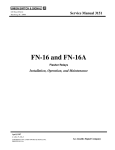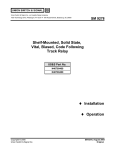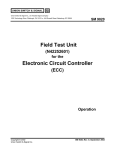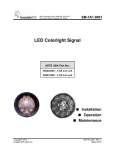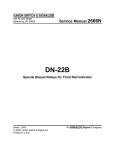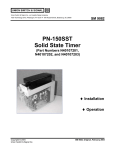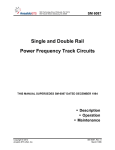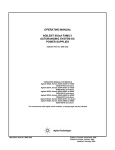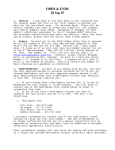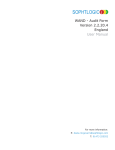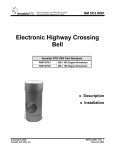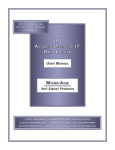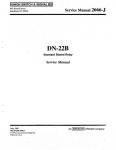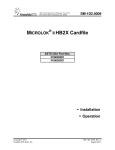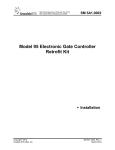Download SM-9277 - Ansaldo STS
Transcript
Union Switch & Signal Inc., an Ansaldo Signal company 1000 Technology Drive, Pittsburgh, PA 15219 ● 645 Russell Street, Batesburg, SC 29006 SM 9277 Shelf-Mounted, Solid State, Biased, Code Following Relay US&S Part No. N40700403 ♦ Installation ♦ Operation Copyright © 2005 Union Switch & Signal Inc. SM 9277, August 2005 Original Proprietary Notice This document and its contents are the property of Union Switch & Signal Inc. (hereinafter US&S). This document has been furnished to you on the following conditions: no right or license under any patents or any other proprietary right in respect of this document or its content is given or waived in supplying this document. This document or its content are not to be used or treated in any manner inconsistent with the rights of US&S, or to its detriment, and are not to be copied, reproduced, disclosed to others, or disposed of except with the prior written consent of US&S. Important Notice US&S constantly strives to improve our products and keep our customers apprised of changes in technology. Following the recommendations contained in the attached service manual will provide our customers with optimum operational reliability. The data contained herein purports solely to describe the product, and does not create any warranties. Within the scope of the attached manual, it is impossible to take into account every eventuality that may arise with technical equipment in service. Please consult your local US&S Account Executive in the event of any irregularities with our product. We expressly disclaim liability resulting from any improper handling or use of our equipment, even if these instructions contain no specific indication in this respect. We strongly recommend that only approved US&S spare parts be used as replacements. SM 9277, Original, August 2005 i Revision History Revision History Rev. Original ii Date Nature of Revision August 2005 Initial Release of Manual SM 9277, Original, August 2005 Table of Contents Table of Contents 1 Introduction............................................................................................................................................................ 1-1 1.1 Application Considerations ................................................................................................................... 1-2 1.1.1 Overcoming Contact Dependence ................................................................................................ 1-2 1.2 Glossary................................................................................................................................................ 1-3 2 2.1 2.2 2.3 Equipment Description ........................................................................................................................................ 2-1 Contacts and Current Ratings .............................................................................................................. 2-1 Isolation for Biased Solid-state Relays ................................................................................................. 2-1 Voltage Requirements .......................................................................................................................... 2-1 3 3.1 Installation.............................................................................................................................................................. 3-1 Relay Wiring.......................................................................................................................................... 3-1 4 4.1 4.2 Operation/Testing ................................................................................................................................................. 4-1 Operation .............................................................................................................................................. 4-1 Test Procedure ..................................................................................................................................... 4-1 5 Technical Support................................................................................................................................................. 5-1 List of Figures Figure 1-1 Figure 1-2 Figure 1-3 Figure 3-1 Figure 4-1 Figure 4-2 - Typical Shelf-Mounted, Solid-State, Code Following Relay.......................................................... 1-1 - Steady Energized Relay (EMCFR)................................................................................................ 1-4 - Independent Contacts with ECFR ................................................................................................. 1-5 - Overall Dimensions of the Slid State, Code Following Relay ....................................................... 3-2 - Pin-Out Information for the Solid State, Shelf Mounted Relay ...................................................... 4-1 - Test Fixture for the Shelf-Mounted Solid-State Code Following Relay......................................... 4-2 List of Tables Table 1-1 - Cross References for Solid-State/Electromechanical Shelf-Mounted Relays................................ 1-2 Table 1-2 - Differences in Application of EMCFR and ECFR Relays .............................................................. 1-3 Table 2-1 - Specifications for the Solid State Code Following Relay................................................................ 2-1 SM 9277, Original, August 2005 iii Table of Contents iv SM 9277, Original, August 2005 Introduction 1 Introduction This service manual provides installation and operation information for Union Switch & Signal’s shelf-mounted, solid-state, biased, code following relay (Figure 1-1). This relay provides a solid-state option for customers with existing electromechanical code following relays. Table 1-1 cross references the US&S shelf-mounted, solid-state relay to the US&S electromechanical CD style “cookie jar” relay. The shelf-mounted, solid-state relay is a code following relay comprised of two circuit boards each containing four solid-state switches. The two boards are housed in a W400 style enclosure. On each of the boards, two of the switches are used as front contacts, and two are used as back contacts. All of the switches are normally open devices, therefore, to emulate a back contact function it is necessary to apply steady energy to one set of terminals on the upper terminal block to enable the back contact switches. Applying energy to another set of terminals activates the front contact switches and opens the back contact switches. In the event that back contacts are not required, it is not necessary to enable them, because the front contact switches will operate independently. The two circuit boards operate together to form a 4FB relay. The circuit boards are designed for low-voltage applications. The low-voltage unit can support load currents from 2.5 amperes up to 30 VDC, 22 volts Vrms AC. Breakdown voltage across a normalreverse contact set is limited by the surge protection ratings of 34 VDC for low-voltage contacts. . Figure 1-1 - Typical Shelf-Mounted, Solid-State, Code Following Relay SM 9277, Original, August 2005 1-1 Introduction Table 1-1 - Cross References for Solid-State/Electromechanical Shelf-Mounted Relays CDP Style Relay Voltage Ohms Contacts Solid-state Replacement Contact Application N223414 8-12 135 4FB LV N40700403 4FB LV AC/DC #1,2,3,4 The main difference between the solid-state relay and the electromechanical relay is that a steady energy source must be connected to the solid-state relay to activate the back contacts. 1.1 Application Considerations Other than the obvious difference that a steady energy supply must be used to duplicate operation of an electronic code following relay (ECFR) to its electromechanical code following relay (EMCFR) counterpart, there are differences that need to be considered that relate to safety. The differences between the ECFR and EMCFR are presented in Table 1-2. 1.1.1 Overcoming Contact Dependence In some safety critical applications a vital relay is steady energized proving that the EMCFR is following code. The general way in which this is accomplished is illustrated in its simplest form in Figure 1-2. A snub on AFP and ABP delays drop-out for sufficient time so that AFP and ABP remain steady energized as long as A is following code. When coding stops, either AFP or ABP drops as does AP. This technique is valid with EMCFR’s because front and back contacts cannot simultaneously be closed. This technique is not valid for the ECFR because the contacts are independently driven and can be simultaneously closed. The same function can be accomplished with an ECFR in one of two ways as shown in Figure 1-3. Circuit A of Figure 1-3 uses a single transfer contact and diodes to achieve a voltage negative with respect to N12; Circuit B accomplishes the same function with marginally better efficiency using two transfer contacts. In either case, AP, which must be a biased neutral relay, will energize when A is following the code. It is a vital mechanism that ensures AP will deenergize when A is not following the code. It overcomes the problem inherent with ECFRs that shorting of front and back contacts together is a possibility. The circuit elements to duplicate these circuits are packaged on a PC board that is compatible with relay rack mounting. 1-2 SM 9277, Original, August 2005 Introduction Table 1-2 - Differences in Application of EMCFR and ECFR Relays Parameter EMCFR ECFR Recommendation or Comment Calibration Pick-Up and Drop-Away are determined by the force generated by a magnetic structure and the restraining forces of contact springs and/or magnets. It is implied that pick-up and drop-away are thus assured. Pick-up and Drop-Away are primarily determined by photovoltaic devices for which there is no implied guarantee that it will never change. These devices have proven highly repeatable but calibration should not be regarded as absolute. Do NOT use an ECFR in an application in which calibration is critical to safety. Note – in most applications this is not a factor.* Contact Dependence Contacts are driven by a common element and, therefore, a welded contact will prevent opposite state contacts from conducting. Contacts are independent. A shorted contact, analogous to one that is welded, will not inhibit the others from functioning normally. Do NOT use an ECFR in an application where dependent contact operation is critical to safety. (An example of overcoming this problem is presented in Section 1.1.1.) Inductive Load Switching Preferred practice in switching inductive load relays is to snub the load to prevent arching, EMI, and contact corrosion. Transient protection is an integral part of the solid-state switches. External snubbing and arc suppression devices are unnecessary. Line-to-line and line-to-ground arrestors are recommended for circuits that exit the house or case. Short Circuit Protection A short circuit can damage the relay and possibly initiate a fire in the wiring. With the low voltage contacts, a short circuit will cause no damage to the wiring or the ECFR. There should be less concern about short circuits with the ECFR. Code Following Integrity and Reliability Contacts open and close substantially matching the ON time of the code but erode with time; this causes code ON time distortion and eventually contact failure. The rate of contact failure is accelerated at higher code rates and contact loading. In cab signal applications, the point on the waveform of circuit interruption is random. Code ON time is more consistent. There is no wear out mechanism and, therefore, no degradation of performance regardless of code rate and contact loading. For those applications wherein the code follower is repeating ON-OFF switching from a code generator, the ECFR is a superior device. In cab signal applications, the point of circuit interruption occurs at the zero crossing resulting in less harmonic noise generation than would otherwise occur. *Low resistance coil relays generally used as track relays are examples where calibration is critical to safety. Relays discussed in the manual are not suitable for that or similar applications. 1.2 Glossary Coded Energy The signal that activates alternate closure of the front and back contacts. Steady Energy The voltage applied to the relay so that the contacts alternately switch when coded energy is applied. SM 9277, Original, August 2005 1-3 Introduction snub EMCFR A AFP snub ABP AFP ABP AP Figure 1-2 - Steady Energized Relay (EMCFR) 1-4 SM 9277, Original, August 2005 Introduction CIRCUIT A ECFR B12 _ + AP A _ + + _ N12 CIRCUIT B B12 ECFR _ + A _ + AP A _ + N12 Figure 1-3 - Independent Contacts with ECFR SM 9277, Original, August 2005 1-5 Introduction 1-6 SM 9277, Original, August 2005 Equipment Description 2 Equipment Description A summary of the specifications for the relay described in this manual are presented in Table 2-1. 2.1 Contacts and Current Ratings The relay is for low voltage applications, and an AC/DC switch is provided. The load rating is 2.5 amperes per contact up to 30 volts DC and 22 Vrms. Low voltage contacts are protected up to 34 volts and are short circuit protected. Breakdown voltage across a normal-reverse contact set is limited by the surge protection ratings of 34 VDC for low-voltage contacts. 2.2 Isolation for Biased Solid-state Relays The steady power source and code input are isolated. Contacts and inputs are isolated from each other and the frame; the withstand voltage is 1500 Vrms. Breakdown voltage across a front-back contact set is limited by the surge protection ratings of 34V. 2.3 Voltage Requirements The operating voltage for the relay is 8 to 16 volts DC. Ripple must be limited so that the instantaneous voltage does not drop below 8 volts. Table 2-1 - Specifications for the Solid State Code Following Relay Parameter Operating Voltage Contact Load Rating Value 8 to 16 VDC (can not drop below 8 VDC) Hold Current 0.06 to 2.5 Amps Voltage 12 to 230 Vrms Contact Protection Up to 230 volts (Contacts are NOT shortcircuit protected. External fusing is required for short circuit protection.) Operating Temperature Range -40°C to +70°C Overall Dimensions SM 9277, Original, August 2005 Height 9.25” Width 4.56” Length 6.0” 2-1 Equipment Description 2-2 SM 9277, Original, August 2005 Installation 3 Installation The solid-state, shelf-mounted relays may be installed either on a horizontal shelf or mounted to a panel and installed in an equipment rack. The shelf-mounted relays do no utilize index plates. The dimensions for installing the relay are presented in Figure 3-1. These relays operate as a 4FB relay; the terminal pinouts are shown in Figure 4-1. 3.1 Relay Wiring For the shelf-mounted, solid-state relay, the coded and steady energy, as well as the contact connection points, are connected to AAR terminals on the top of the unit. Positive coded energy is wired to terminal +Coded, negative coded energy is wired to terminal -Coded. Positive steady energy is wired to terminal +12 Steady; negative steady energy is wired to terminal -12 Steady. (See Figure 4-1.) SM 9277, Original, August 2005 3-1 Installation 6” 4.56” 3.5” .53” .63” 2.25” .53” .63” 1.19” .81” .31” .14” R. .25” 7.63” 7.5” .56” 8.5” 7.13” 8.19” 9.25” .25” R. 2.25” .28” DIA HOLE 6” Figure 3-1 - Overall Dimensions of the Slid State, Code Following Relay 3-2 SM 9277, Original, August 2005 Operation/Testing 4 Operation/Testing 4.1 Operation The shelf-mounted relay operates as a 4FB relay and must be wired as described in Section 3.1. The applied coded energy closes the front contact switches and opens the back contact switches. 4.2 Test Procedure No periodic testing or adjustment is necessary. There are no calibration or adjustments required on the solid-state relay. Testing a solid-state relay differs slightly from testing an electromechanical relay. A minimum operating voltage replaces the pick up calibration. Testing consists of energizing the relay with 8 volts DC and observing that the contacts close. An AC source is used to indicate contact closure. To test the shelf-mounted relay, connect it to a test fixture wired as shown in Figure 4-2. 1. Turn on the AC power by closing switch SW1. No lamp should be illuminated. Any lit lamp indicates a shorted switch. Figure 4-1 - Pin-Out Information for the Solid State, Shelf Mounted Relay (Viewed from the Top of the Relay) SM 9277, Original, August 2005 4-1 Operation/Testing 2. Close switch SW2. Lamps L5, L6, L7, and L8 should be illuminated. Any lamp not illuminated indicates an open switch. (This assumes that the indicator lamps are intact. If a lamp is not lit, the bulb can be checked by shorting the front or back contact wire to the heel contact wire. With this short the bulb should light.) 3. Close switch SW3. Lamps L5, L6, L7, and L8 should extinguish, and lamps L1, L2, L3, and L4 should illuminate. Any lamp not illuminated indicates an open switch. (This assumes that the indicator lamps are intact. Check the bulb per Step 2 if it is not lit.) 4. If the test results are satisfactory, the relay test is complete. Return all switches to their "off" position. 5. If the relay fails the test, US&S recommends returning the relay to their Batesburg, SC facility for repair. L1 L2 L3 SW1 F1 L4 T1 + TO 120 V AC LINE _ L5 L6 L7 L8 TO 1F TO 2F TO 3F TO 4F TO 1B TO 2B TO 3B TO 4B TO 1H TO 2H VOLTAGE REGULATOR TO 3H LM7808 D1 TO 4H + C1 SW2 SW3 TO +12 STEADY TO + CODED TO -12 STEADY TO - CODED T1: TRANSFORMER, 120 V AC TO 12 V AC, 2 AMPERES OR BETTER L1 - L8: LAMPS, #1891, 1892, OR 1893 D1: BRIDGE RECTIFIER, 100-VOLT, 5-AMPERE SW-1, 2, 3: SPST SWITCH C1: 100 MFD, 50-VOLT F1: 120 VOLT, 3-AMPERE FUSE, AND HOLDER MISC: LAMP SOCKETS, WIRE MOUNTING BASE, AND RECEPTACLES Figure 4-2 - Test Fixture for the Shelf-Mounted Solid-State Code Following Relay 4-2 SM 9277, Original, August 2005 Technical Support 5 Technical Support The Rapid Action Information Link Team (RAIL Team) is a group of experienced product and application engineers ready to assist you to resolve any technical issues concerning this product. Contact the RAIL Team at 1-800-652-7276 or by e-mail at [email protected]. SM 9277, Original, August 2005 5-1 Technical Support 5-2 SM 9277, Original, August 2005




















